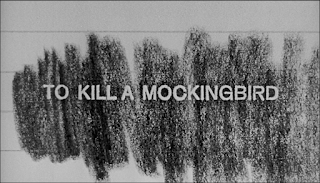Screenplay by Horton Foote
Adapted from the novel To Kill a Mockingbird by Harper Lee
Jean Louise "Scout" Finch is growing up in small-town Alabama during the Great Depression. Her happiest days are spent in the summer with her brother Jem and friend Dill, playing and speculating about their mysterious and reclusive neighbor, Arthur "Boo" Radley. Then Scout's life is turned upside-down when her father, an attorney named Atticus, is appointed to defend Tom Robinson, a black man accused of raping a white woman.
This is one of those cases in which both the movie and the book are fantastic, but they're also quite different. Overall, the story and its messages are fairly consistent, but many of the details were changed. The book has a lot of minor characters whom the film eliminates, combines, or makes even less important. For example, Scout and Jem meet up with Dill when he comes to stay with their neighbor, who is his aunt, for the summer. In the book, two of their neighbors are Miss Stephanie and Miss Rachel, and Rachel is Dill's aunt. In the movie, these two are combined into one character: Dill's Aunt Stephanie. Another character, Mrs. Dubose, is very important in a section of the novel that is completely eliminated from the film, although she at least makes an appearance in the movie, unlike Atticus's sister, Aunt Alexandra, who is absent entirely.
Most of the changes, including some of the character eliminations, have to do with the length of time the story spans. Both versions begin in the summer and end on Halloween, but in the book this is the Halloween two years later, whereas in the movie, it's only one year later. In this way, it makes sense that a lot happens in the book that is cut out of the film, since the book has a whole extra year to account for. While the novel does include some wonderful scenes that I would have liked to see in the film, I completely understand why the filmmakers decided to condense the story. The movie introduces the trial much earlier than the book does, and thus shifts more of the focus of the story to that aspect. There's an added scene in which Scout, Jem, and Dill sneak into the courthouse to try to see where Boo Radley was allegedly locked up at one point, and unintentionally witness the indictment. The book doesn't even mention Tom Robinson until much later, although his trial does dominate the second half.
In short, while the book spends a lot of time establishing what everyday life in that town is like, the movie skips right to the more dramatic parts of the story. I think to some extent the extra background information in the book adds to the tragedy because we get to know more of the people involved better, but the movie includes enough that it doesn't suffer too much from the missing secondary character development. Some of the sections of the book, while riveting on the page, would probably have been fairly boring in the film. For the most part, I think the right choices were made regarding what to keep, what to eliminate, and what to alter.
Well, it's been a year since I started this project, and I've gotten through 31. I'm hoping to get through even more this coming year, but that might be unrealistic, especially given that the next winner is adapted from an 18th century novel that is over 900 pages long. But if I ever get through it, I'll be blogging about Tom Jones, based on the novel The History of Tom Jones, a Foundling by Henry Fielding.

No comments:
Post a Comment